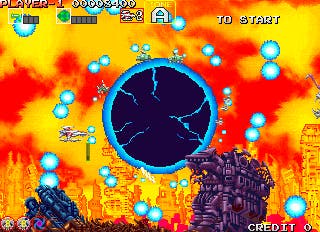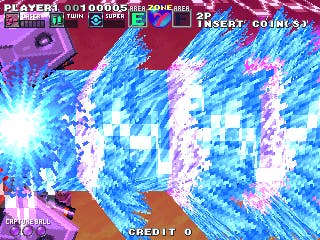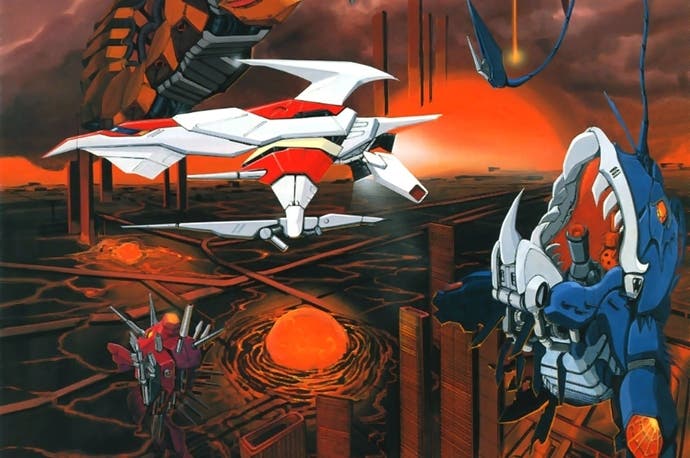Darius retrospective
Battered-carp Galactica
Darius is a series defined by grand scale - from the magnitude of its iconic bosses and the cabinets they built to contain them, to the scope of its universe and the ambition of its creative designers.
When the first game appeared in Japanese game centres at the end of 1986 it made an audacious bid for the hearts and coins of players. The cabinet demanded attention, housing a colossal three screen set-up and booming body-sonic seats that rattled the spine. Though it wasn't the first tri-screen arcade game as it's often credited, it was the first to marry such high-impact engineering with the creative presentation to back it up.
Darius was the gaming equivalent of the Ultra Panavision technology that powered films like Ben-Hur in the 1950s and Taito's visionaries saw the power of filling players' entire periphery with endless panoramas of colour and detail. The innovative branching stage format that sees you cutting your own path through its tangled alphabet map further sells the interstellar scale of the Darius world, as it can never be seen entirely in a single sitting.

Huge cabinets and plentiful routes perfectly demonstrate the series' scale in the corporeal realm, but thematically the scope is just as vast. It's often said that we know more about space than we do the Earth's oceans. In taking mysterious dwellers from the deepest fathoms of the ocean and casting them in the near-infinite expanse of space, Darius crafts a world that combines the vastness of both, forging something relatable and alien. Observers often label the series' unique fusion of space and mechanical sea creatures as bizarre, yet this biological concept is far more relatable to human beings than typical genre antagonists. At least we share common DNA with the nautical entities that inspire its design.
Taito's obsession with depicting the most bizarre creations known to marine biology leans on the alien nature of the deepest deep. The more bizarre the creature, the more shocking it is to discover that it truly exists - Yes, G Darius' Tripod Sardine is actually a thing (give or take some metal and lasers) and even fancifully embellished creatures like Darius Gaiden's Neon Light Illusion are rooted in nature, amping up the bioluminescence of the bigfin reef squid.
Like the movie terrors in a stop-motion Harryhausen film, Darius' giant bosses are charismatic heels. There's a disarming comic mischief to their behaviour that allows players to laugh along with them, as well as fearing them. Take for example Darius 2's WW2 Imperial Japanese battleship Yamato. Midway through the uncharacteristically stock battle, a giant mechanical hermit crab bursts forth from the hull and attacks, scuttling violently around the screen while wearing the ship's remains as a hat.
Or Darius Gaiden's Deadly Crescent, where the monster extends its mouth across the screen in a move that resembles a kiss, more than an attempt on your life. Taito's designers infused their creations with such charisma, it's impossible not to fall in love with them, no matter how many times they kill you. With the heroes of the story lacking any significant character or personality, Darius' relationship with you as a player hinges on your connection to the aquatic rogues. It was therefore a stroke of genius when Darius Gaiden allowed you to capture the mid-boss Captains and forge an alliance with your adversaries, connecting you even more closely with the fish that had formerly only existed as foes.

These larger than life characters demand an equally vast universe. Darius' strikingly abstract worlds evoke the imagery of Jean "Mœbius" Giraud's comics - surreal desolate organic environments, tinged with an odd futurism. This is best illustrated in Darius Gaiden - the pinnacle of the series' beauty and one of the most confident and accomplished sprite-based games ever imagined. It's an exquisite journey through 28 zones of flamboyant warping psychedelia and highlights Taito's incredible talent for stage development. Rainbows herald the end of storms, suns set into nightfall while boss battles rage and solar eclipses flare as celestial objects shift in to place.
As the series grows, so does the scale and with the advent of polygons in G Darius, extravagant set pieces densely pack each zone. From the Granulated Star zone where planets are obliterated all around you as you navigate the debris, to the abstract insanity of Genesis where you witness the birth of the eponymous Darius planet - each zone tells its own story. This climaxes with the austere Grave of Culture zone, where sparse lightning strikes illuminate a devastated city.
Like a classic horror movie reveal, the final lightning strike exposes the source of the destruction looming in the darkness - the recurring series true last boss; Great Thing. Each zone is alive with such cosmic drama you'll want to explore them all just to see the spectacle unfold. For a genre not often credited with dramatic presentation, G Darius is an evocative and inspiring voyage. 2010's Dariusburst Another Chronicle tends towards brute force scale - enemies that dwarf your tiny Silver Hawk many hundred times over and occupy entire screens by themselves - and demonstrates Taito's tight grasp on the series' identity, even after the 13-year hiatus.
Composed around the concept of "a large existence," Darius' music beautifully expresses the scale of both its iconic bosses and the expanse of space. Hisayoshi Ogura, founder of Taito's legendary in-house band Zuntata, claims that it is written "with the game rather than for the game," and indeed it's impossible to fully explain its appeal without examining the landmark sound design. Although its collective signature sound is unmistakable, each entry is conceptual and distinct in tone. Ogura cites an eclectic mix of muses that inform his work: early electronic music pioneers Yellow Magic Orchestra, the prime numbers found in mathematics, Jungian psychology and the Christian Bible have all inspired his otherworldly compositions.
Following the resoundingly positive response to the first game's music, Ogura refused to rest on his laurels, instead forcing himself in new directions with each successive entry. Outside of Nintendo, few software creatives can claim to influence hardware design. Such was the impact of Ogura's revolutionary Darius score that Zuntata determined the audio specs of the arcade hardware that powered the sequel.
The haunting avant-garde brilliance of the first game's music gave way to a far warmer score for the sequel, reflecting the birth of Ogura's daughter - the same daughter immortalised in the "papa" sample heard in Darius 2's main theme. Darius Gaiden took the series in an entirely new direction with a stunningly operatic fusion score that shattered conventions in both form and delivery. Ignoring the one track per level convention, the opening tracks bleed seamlessly between stages like a progressive concept album, and they're synced to the game's equally experimental visuals. G Darius marked another audio rebirth with a bizarrely syncopated industrial score centred on the concept of organic-inorganic chimeras, and despite Ogura only creating one piece of music in 2009's Dariusburst renaissance, the modern-day Zuntata band channelled an astonishing contemporary sound track that lived up to the series pedigree in every way.

Though the nautical theme soaks into every element of the art direction, Darius is also filled with oceanic allusions that inform its mechanics. What is G Darius' capture ball if not a rod to catch your most impressive specimen? Casting it out to hook a lunker of a Captain only to accidentally reel in the pea-shooting equivalent of a boot can make for a disappointing fishing trip. Dariusburst Another Chronicle takes inspiration from nature by expanding the formation-based scoring of the series and infusing it with life. Huge schools of fish-like foes organically writhe around the screen in beautifully natural patterns. Even the projectiles spewed forth from the bosses display more organic behaviour than standard artillery. Take Golden Ogre's scale-shedding assault or Great Thing turning the tables on whale hunting humans by launching mile-long harpoons at your Silver Hawk.
With so much of Darius' appeal found in its artistry, there can be a tendency to neglect its exemplary mechanics. Make no mistake; the abundance of style should never be viewed as a stand-in for substance. The two 80s games turned heads because of their irresistible art direction, but they're also a master class in meticulous design and measured power-up distribution. While they were clearly products of their era - stubbornly demanding and ruthlessly unforgiving - the sumptuous Darius Gaiden is one of the most balanced and refined games in the genre and it's no exaggeration to label the superbly technical G Darius as one of the greatest shooting games ever realised.
And so to the 21st century. For a series defined by scale, the PSP's 4-inch screen was never going to be enough to contain Dariusburst. The Another Chronicle arcade release brings the series full-circle with an outrageously bombastic 32:9 dual widescreen cabinet. Crossing four players' burst beams against gargantuan bosses to unleash Egon Spengler levels of destruction is an exhilarating experience, and Chronicle mode decisively delivers on the branching route concept with a galactic swathe of content.
28 years on and Darius has lost none of its power to excite and inspire. Charting its grand ambition and cosmic scope may well present a fine account of Taito's masterpiece, but it's series that demands to be experienced first hand. If you fail to be roused by its intoxicating charm and heady charisma, perhaps video games aren't for you. I have heard that fishing is fun.
